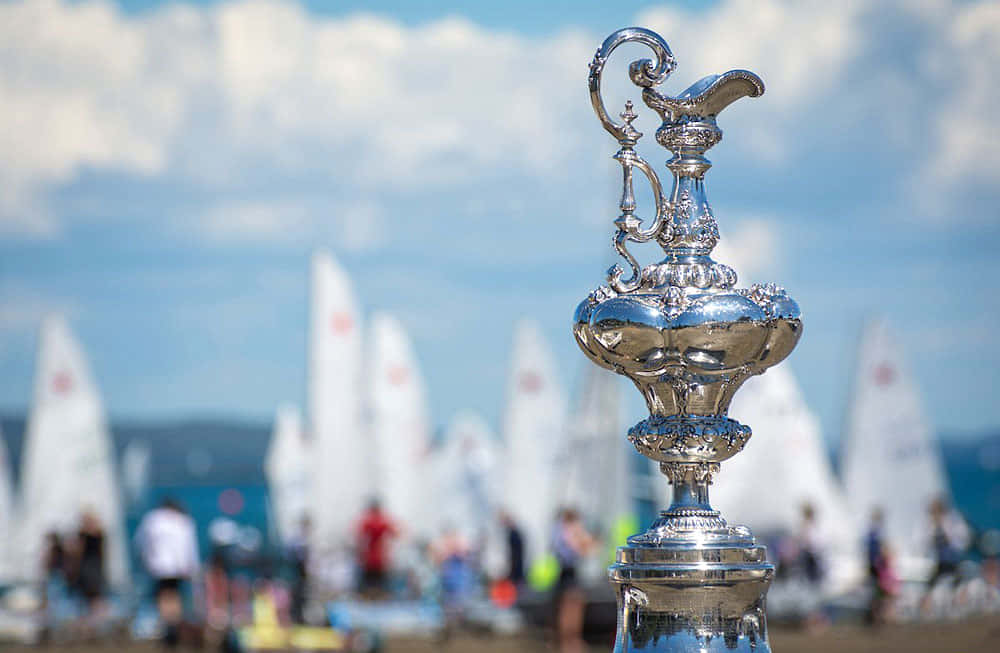
New Boats Azimut Yachts Benetti Yachts Sea Water RIBs Pre-owned & Demo Boats Stock & demonstration boats Pre-owned Motor Boats Pre-owned Sailing Boats Superyachts Services News About Contact
Pinnacle Marine
The painting above depicts one of the most famous events in the history of yachting. The location is the Isle of Wight in England, the date is August 22 1851, the schooner in the centre is the America, and the event is a 53-mile race around the island. The America triumphed, beating 14 other contestants and coming in more than 20 minutes ahead of her nearest rival. And thus was born the America's Cup – the oldest trophy in international sport.
The story began a year earlier when news reached America that England would soon be organizing the Great Exhibition. Hosted at the Crystal Palace in London's Hyde Park, the fair was to be an exposition of arts and industry, and many Americans were invited to attend. One such American was Mr John Stevens, commodore of the recently-founded New York Yacht Club. A British merchant suggested to Mr Stevens that he use the exhibition to showcase his country's boat building skills and demonstrate the superior performance of New York pilot boats.
Mr Stevens seized the opportunity and immediately set about building the America, a 95-feet schooner designed to be faster than any other vessel in the United States. She was launched in May 1851 and delivered to her owners the following month.

When news of the America's construction reached England, the Royal Yacht Squadron in Cowes wrote to Mr Stevens and invited him to bring the yacht to the Isle of Wight. Mr Stevens graciously accepted the offer and prepared for the Atlantic crossing. The America departed New York in June and after drydocking and repainting in Le Havre, arrived at the Isle of Wight on July 31.
The following morning presented an opportunity for Commodore Stevens to show off his sleek new yacht. A breeze at about 9am heralded the arrival of the Laverock, a 70-ton cutter that had sailed out from Cowes to take a look at her American guest. The two yachts then embarked on an informal race, but the outcome is disputed. While some British newspaper reports claimed the Laverock held her own, other sources describe how the America won easily and cite this race as the first evidence of her invincibility.
Buoyed by the success of this encounter, Mr Stevens issued a challenge to race the America against any fleet of schooners the British could assemble, and then a second challenge to race her for a stake of anything from a simple cup up to a purse of 10,000 guineas. Only one Englishman – the famous engineer Robert Stephenson – stepped forward to accept the challenge. The race took place on August 28 and the America won. But this is irrelevant. The race that mattered was held 6 days earlier on August 22.
The New York Yacht Club, in order to test the merits of the different models of the schooners of the Old and New World, propose through Commodore Stevens to the Royal Yacht Squadron to run the yacht America against any number of schooners belonging to any of the yacht squadrons of the kingdom, to be selected by the Commodore of the Royal Yacht Squadron.
New York Yacht Club, 1851
This was the day history was made. The Royal Yacht Squadron organized a 53-mile race around the Isle of Wight, the prize being a large silver ewer worth 100 sovereigns. The race had been held before, but only for British yachts. This year however, in the spirit of London's Great Exhibition and the invitation the Royal Yacht Squadron had extended to Commodore Stevens, the terms were altered so that foreign yachts could also compete.
Eighteen schooners and cutters were assembled at the starting line when the gun fired at 10am. Three failed to start, but the other 15 were away within 30 seconds. Following the contestants were an official steamer carrying the race committee and a sprawling flotilla of onlookers in boats of all shapes and sizes.
The America lagged for a while and after just over an hour was in fifth place and 2 minutes behind the leader. Soon after, though, she advanced rapidly to the front of the pack and retained the lead for the rest of the race. As she approached the Needles on the western side of the island she passed Queen Victoria's royal yacht, a paddle steamer named Victoria and Albert. Queen Victoria waited a while for the America's closest challenger, the Aurora, and then returned to her summer home, Osborne House. By now the race was pretty much decided and at just after 8.30pm the America sailed across the finishing line, more than 20 minutes ahead of the Aurora.
The following day Queen Victoria went on board the America to chat to Commodore Stevens, congratulate him on his victory and take a close look at the yacht. In the evening the victors attended a firework display and a party at the Royal Yacht Squadron's club house. Events concluded with the presentation of what is now the oldest trophy in international sport.

There are lots of articles about the history of the America's Cup, but many of them contain inaccuracies. For example, an early 20th-century publication by the Royal Yacht Squadron gives the date of the race as August 23. Other sources claim the Aurora came in 8 minutes behind the America, whereas the official finishing times for these yachts were 20H34 (20H37 railway time) and 20H58.
The best primary source we're aware of is an article that appeared in the London Illustrated News. Written by a yachting enthusiast who was undoubtedly present at the regatta, much of the text was reproduced verbatim in The Lawson History of the America's Cup, published in 1902.
